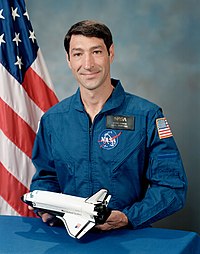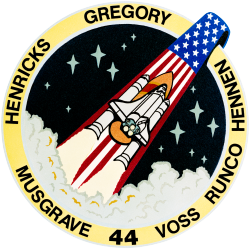Mario Runco
| Mario Runco, Jr. | |
 | |
| NASA Astronaut | |
|---|---|
| Född | 26 januari 1952 New York |
| Tid i rymden | 22 dygn, 23 timmar, 8 minuter |
| Urvalsgrupp | Astronautgrupp 12 |
| Antal rymdpromenader | 1 |
| Rymdpromenadtid | 4 timmar, 28 minuter |
| Uppdrag | STS‑44, STS‑54, STS‑77 |
| Uppdragsemblem | |
Mario Runco, född 26 januari 1952, är en amerikansk astronaut uttagen i astronautgrupp 12 den 5 juni 1987.
Rymdfärder
Källor
”Biographical Data” (på engelska) (PDF). NASA. januari 2018. https://www.nasa.gov/wp-content/uploads/2016/01/runco_mario.pdf?emrc=004be8. Läst 5 maj 2024.
Media som används på denna webbplats
The STS-77 crew patch displays the Shuttle Endeavour in the lower left and its reflection within the tripod and concave parabolic mirror of the SPARTAN Inflatable Antenna Experiment (IAE). The center leg of the tripod also delineates the top of the Spacehab's shape, the rest of which is outlined in gold just inside the red perimeter. The Spacehab was carried in the payload bay and housed the Commercial Float Zone Furnace (CFZF). Also depicted within the confines of the IAE mirror are the mission's rendezvous operations with the Passive Aerodynamically-Stabilized Magnetically-Damped satellite (PAM/STU) appears as a bright six-pointed star-like reflection of the sun on the edge of the mirror with Endeavour in position to track it. The sunlight on the mirror's edge, which also appears as an orbital sunset, is located over Goddard Space Flight Center, the development facility for the SPARTAN/IAE and Technology Experiments Advancing Missions in Space (TEAMS) experiments. The reflection of the Earth is oriented to show the individual countries of the crew as well as the ocean which Captain Cook explored in the original Endeavour. The mission number 77 is featured as twin stylized chevrons and an orbiting satellite as adapted from NASA's logo. The stars at the top are arranged as seen in the northern sky in the vicinity of the constellation Ursa Minor. The field of 11 stars represents both the TEAMS cluster of experiments (the four antennae of GPS Attitude and Navigation Experiment (GANE), the single canister of Liquid Metal Thermal Experiment (LMTE), the three canisters of Vented Tank Resupply Experiment (VTRE), and the three canisters of PAM/STU) and the 11th flight of Endeavour. The constellation at the right shows the fourth flight of Spacehab Experiments.
STS-54 Mission Insignia
portrait astronaut Mario Runco
STS-44 Mission Insignia




